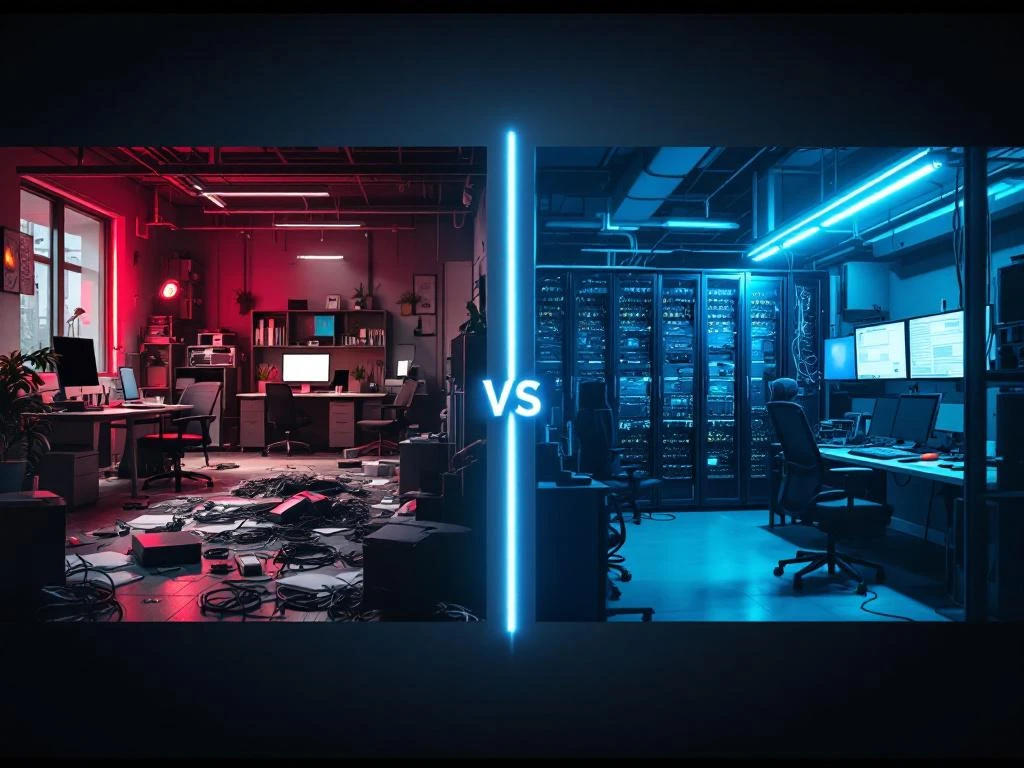
Break-fix and managed onsite support represent two fundamentally different approaches to IT maintenance. Break-fix support operates reactively, where technicians respond only when equipment fails or issues arise, charging per incident without ongoing monitoring. Managed onsite support, however, provides proactive, continuous IT service with dedicated technicians who regularly maintain systems, conduct preventive maintenance, and function as extensions of your internal IT team. The choice between these models significantly impacts your operational efficiency, budget predictability, and overall IT reliability.
What exactly is break-fix IT support?
Break-fix IT support is a reactive service model where technicians are called only when something goes wrong. Think of it like calling a plumber when your pipes burst rather than having regular maintenance checks. When your server crashes, network fails, or hardware malfunctions, you contact a technician who arrives to diagnose and fix the specific problem.
This pay-per-incident approach means you’re billed for each service call, typically including labour hours, travel time, and any replacement parts. Response times vary widely depending on technician availability and your service agreement, ranging from same-day emergency response to several days for non-critical issues. The transactional nature means different technicians might handle each incident, leading to inconsistent service quality and varying levels of familiarity with your systems.
Break-fix support works without ongoing maintenance schedules or system monitoring. Technicians arrive, fix the immediate problem, and leave without addressing potential future issues or conducting preventive measures. This model appeals to businesses with limited IT budgets or those with simple, stable systems that rarely fail. However, the unpredictable nature of both costs and downtime can create significant challenges for operations that depend heavily on IT infrastructure.
How does managed onsite support work differently?
Managed onsite support takes a completely different approach by providing proactive, continuous IT service. Instead of waiting for problems to occur, dedicated technicians regularly visit your facilities to maintain systems, update software, check hardware health, and identify potential issues before they cause disruptions. These technicians become familiar with your specific environment, understanding your unique configurations and business requirements.
The key difference lies in the employment model and service consistency. With managed support, you work with employed technicians rather than random subcontractors, ensuring consistent service quality and accountability. These professionals follow established preventive maintenance schedules, conducting regular system health checks, firmware updates, and performance optimisations that keep your infrastructure running smoothly.
Quality standards remain consistent because the same technicians handle your account, building deep knowledge of your systems over time. They function as extensions of your internal IT team, understanding your procedures, security protocols, and operational priorities. This continuity means faster problem resolution, better communication, and technicians who can anticipate issues based on their experience with your specific environment. The proactive approach significantly reduces unexpected downtime and emergency situations.
What are the main cost differences between these models?
The pricing structures between break-fix and managed support differ fundamentally in predictability and total cost of ownership. Break-fix support charges per incident, with costs varying based on issue complexity, required parts, and technician hours. Emergency calls often incur premium rates, especially during nights, weekends, or holidays. A single server failure could cost anywhere from hundreds to thousands of pounds, making budget planning nearly impossible.
Managed onsite support operates on predictable monthly fees that cover regular maintenance, monitoring, and a defined scope of services. While the monthly cost might initially seem higher than occasional break-fix calls, the total cost of ownership typically proves lower when considering all factors. Hidden costs in break-fix models include extended downtime impacts, lost productivity during failures, and the cumulative effect of deferred maintenance leading to more frequent and severe problems.
| Cost Factor | Break-Fix Model | Managed Support Model |
|---|---|---|
| Pricing Structure | Per incident, variable costs | Fixed monthly fee |
| Emergency Rates | Premium charges (often 1.5-2x normal) | Included in service agreement |
| Downtime Impact | Extended due to reactive response | Minimised through prevention |
| Budget Predictability | Highly unpredictable | Consistent and plannable |
| Long-term TCO | Higher due to major failures | Lower through preventive care |
Preventive maintenance in managed support models reduces the frequency and severity of failures, translating to fewer disruptions and lower overall costs. When you factor in the business impact of downtime, particularly for mission-critical operations, the value of proactive management becomes clear. A retail chain losing point-of-sale systems or a data centre experiencing extended outages faces revenue losses that far exceed any savings from choosing break-fix support.
Which support model fits your business needs better?
Choosing between break-fix and managed onsite support depends on several critical factors unique to your business. Start by evaluating your operational criticality: if IT failures directly impact revenue or customer service, managed support becomes almost necessary. Businesses operating across multiple locations face additional complexity, as coordinating break-fix services across different regions often results in inconsistent service quality and delayed response times.
Consider these key evaluation criteria for your decision:
- Geographic spread: Multi-site operations benefit from managed support’s consistent service standards and centralised coordination
- Compliance requirements: Industries with strict security or regulatory standards need the documentation and consistency managed services provide
- Budget constraints: While break-fix might seem cheaper initially, evaluate the true cost including downtime impacts
- System complexity: Complex, interconnected systems require the deep familiarity that comes with dedicated technicians
- Growth trajectory: Rapidly expanding businesses need scalable support that grows with them
Break-fix support might suffice for small offices with basic IT needs, minimal compliance requirements, and tolerance for occasional downtime. However, when your business depends on maintaining service level agreements, operating 24/7, or managing distributed infrastructure, managed support becomes the logical choice. The peace of mind from knowing trained professionals actively monitor and maintain your systems often justifies the investment, particularly when considering the potential cost of extended outages or security breaches.
How can IMPLI-CIT help with your onsite IT support needs?
We understand the challenges businesses face when managing IT infrastructure across multiple locations. Our managed onsite support model addresses these pain points through employed technicians who become extensions of your internal team. Unlike traditional break-fix services that rely on random subcontractors, we provide consistent, reliable support through our own trained professionals who understand your specific requirements and maintain your standards.
Our global coverage means you get the same quality service whether your sites are in Amsterdam, London, or Singapore. All our onsite technicians are VCA-VOL safety certified, background-checked, and speak at least Dutch and English, ensuring clear communication and adherence to security protocols. With 24/7/365 availability, we’re ready whenever you need us, eliminating the uncertainty of emergency response times that plague break-fix models.
From deskside support and data centre services to field engineering and site surveys, our comprehensive service offerings cover all aspects of onsite IT support. We specialise in helping businesses maintain operational continuity through preventive maintenance, rapid hardware deployment, and secure logistics support. By partnering with us, you gain access to skilled professionals who combine strong technical expertise with exceptional communication capabilities, delivering the reliability and consistency your business demands. Let’s discuss how we can help transform your IT support from reactive firefighting to proactive management.
Frequently Asked Questions
How long does it typically take to transition from break-fix to managed onsite support?
The transition usually takes 30-60 days, depending on your infrastructure complexity and number of locations. During this period, managed support technicians conduct thorough system audits, document your environment, establish maintenance schedules, and gradually assume responsibility for your IT operations. Most businesses experience improved stability within the first month as preventive measures take effect.
What happens if we need support outside our managed service agreement scope?
Most managed support providers offer flexible arrangements for out-of-scope work, typically at pre-negotiated rates that are lower than standard break-fix charges. These might include major hardware upgrades, office relocations, or special projects. The key advantage is that your regular technicians, who already know your systems, handle this additional work, ensuring consistency and faster completion.
Can we start with managed support for critical systems only and expand later?
Yes, many businesses successfully implement hybrid models where mission-critical infrastructure receives managed support while less essential systems remain on break-fix. This approach allows you to test the managed service relationship, demonstrate ROI to stakeholders, and gradually expand coverage as budget permits. Common starting points include data centres, production servers, or customer-facing systems.
How do we ensure managed support technicians maintain our security standards?
Reputable managed support providers implement strict security protocols including background checks, NDAs, and regular security training for all technicians. Request documentation of their security certifications, ask about their onboarding process, and ensure they can comply with your industry-specific requirements. Many providers also offer dedicated technicians who become familiar with your unique security protocols and access procedures.
What metrics should we track to measure managed support effectiveness?
Key performance indicators include mean time to resolution (MTTR), system uptime percentages, number of preventive maintenance tasks completed, and incident frequency trends. Also track soft metrics like user satisfaction scores and technician response times. Most managed providers offer detailed monthly reports showing these metrics, helping you quantify the value and identify areas for improvement.
Is it possible to switch back to break-fix if managed support doesn't work out?
While technically possible, most businesses find returning to break-fix challenging after experiencing managed support benefits. If considering this option, ensure your service agreement includes reasonable termination clauses and knowledge transfer provisions. However, addressing specific concerns with your managed provider often resolves issues more effectively than reverting to reactive support models.
What is the difference between break-fix and managed onsite support?
